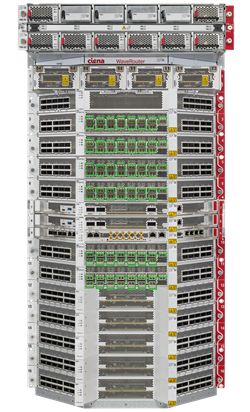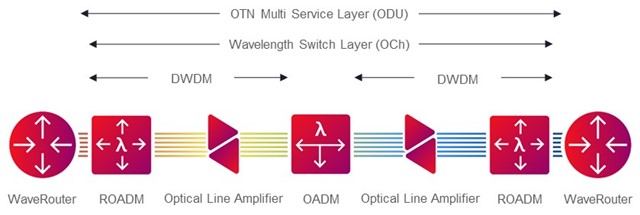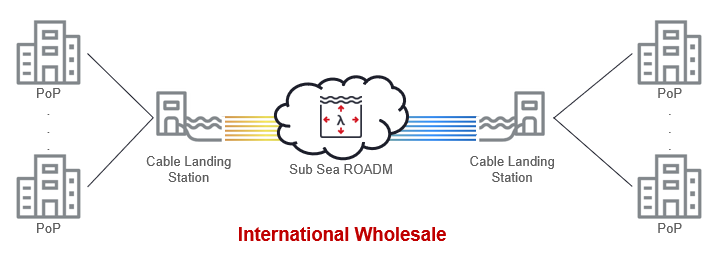Earlier this year, we launched a different way to build a converged metro network with WaveRouter, and the response has been nothing short of amazing. To follow up, Ciena’s Nicola Benvenuti details just a few of the business case examples this unique, purpose-built platform architecture supports to achieve greater simplicity, scale, and sustainability.
 As you hopefully heard, Ciena recently unveiled WaveRouterTM, a reimagined routing platform architecture for the converged metro and a true breakthrough from legacy routing architectures. WaveRouter brings together the latest in IP and optical technology innovation with advanced multi-layer coordinated control to substantially drive down the cost of networking while reducing carbon footprint.
As you hopefully heard, Ciena recently unveiled WaveRouterTM, a reimagined routing platform architecture for the converged metro and a true breakthrough from legacy routing architectures. WaveRouter brings together the latest in IP and optical technology innovation with advanced multi-layer coordinated control to substantially drive down the cost of networking while reducing carbon footprint.
As demand in metro networks increases, you need a more scalable solution that allows your network to flex but also works within the controlled environmental constraints of your operating facilities. However, current metro deployment options, like ortho-direct chassis, spine-leaf, or Distributed Disaggregated Chassis (DDC), often lack the ability to adapt to legacy telco offices and existing dynamics.
WaveRouter’s modern distributed housing and footprint-efficient designs dramatically improve thermal flexibility to address space and power constraints. It offers the flexibility to deploy your metro router in non-adjacent racks and rows, and allows for front-to-back air-cooling efficiency, helping to overcome some of the most common and challenging office thermal limitations.
You asked for a different way to build a converged metro network. We heard you. With WaveRouter's unique, industry-first platform architecture, you will be able to break free from legacy constraints to converge your IP and Optical layers in the metro with ultimate operational simplicity, future-proof scale, and improved sustainability.
But what does this really mean for your network? I’m excited to discuss the possibilities WaveRouter is creating for metro architectures with three different network scenarios.
Example 1: Mobile Network Operator

For the first possibility, let’s consider a national Mobile Network Operator (MNO). MNOs offer direct services and have resilient nationwide networks that offer 4G LTE and 5G. Multiple metro networks are connected together with Dense Wave-Division Multiplexing (DWDM) fiber optic links, which are used to connect Optical Transport Network (OTN) cross-connects with high-performance transponders. The OTN cross-connect enables transport and multiplexing of any digital signal independent from the client (Ethernet, SANs, digital video, etc.). In this case, the clients are IP-MPLS Label Switch Router (LSR) and Label Edge Router (LER) routers.
As a national MNO, the operator has to ensure a high degree of resiliency in the network while wanting to converge their IP and optical networks. It is essential that the converged network also provides a photonic optical control plane for optical link recovery that matches the resiliency of the existing one.
In this use case, the value of using an OTN optical control plane is imperative to their business case – OTN provides isolation of failures from the IP control plane. With a high degree of fiber cuts in their network, the OTN control plane is needed for resiliency. Additionally, in the converged network, a Segment Routing (SR) control plane is also needed. The benefit of a multi-layer approach is to provide resiliency and guarantees to the IP layer, which is a client of the OTN layer. Physical layer faults are addressed by the OTN layer without any impact to the IP layer and dependent services. This preserves the SLA and removes the operational burden of having to re-optimize the IP layer after multiple fiber cuts.
Taking a basic control layer approach with a common IP and optical topology and simply putting a coherent plug in a legacy router would be a band-aid approach, leaving the network and dependent services susceptible to multiple fiber cuts. This is not efficient and forces constant re-optimization, which increases operational maintenance and costs. Using a multi-layer approach is certainly more efficient, albeit at the cost of maintaining multiple devices, which is redundant and costly. What if you could have the benefits of a coordinated multi-layer approach in a single device?
This is where Ciena’s WaveRouter outshines legacy routers, which are primarily built simply with the ability to aggregate and route packets. WaveRouter creates an OTN-like resilient layer that guarantees bandwidth and availability to the IP layer, unlike any other router in the market. This capability can be assigned to specific ports and sub-ports. With this level of flexibility, WaveRouter allows both a multi-layer capability and traditional IP routing on the same platform.
Unlike other metro routing platforms, WaveRouter is optimally designed to scale and evolve via an extensible and flexible converged architecture across multiple dimensions – routing, optical, and compute. Configurations range from 6Tb/s to 48Tb/s to 192Tb/s in incremental 6Tb/s steps of switching capacity.

WaveRouter can support a wide range of plugs and submodules without stranding chipset or fabric capacity— including WaveLogicTM 5 Nano coherent pluggables, WaveLogic 5 Extreme performance-optimized coherent submodules, and the recently announced WaveLogic 6 family. With all of these capabilities, WaveRouter capitalizes on platform flexibility to deliver on flexible futureproof scale.
Example 2: International Wholesaler
Wholesale operators provide shared communications infrastructure, as well as connect data centers, Points of Presence (PoP), Central Offices (COs), and lit buildings.

For the second use case, let’s discuss an international wholesaler. International wholesalers provide connectivity across global wholesale and enterprise customers, enabling them to realize greater business opportunities. Their mission is to connect regional and national networks globally using shared communications infrastructure. In order to successfully navigate that mission and meet growing bandwidth demand, a flexible modular solution is key.
In this scenario, the wholesaler essentially wants to consolidate network layers, simplify multi-layer operations, and reduce power in their network. The result? Dynamic scalability and improved network sustainability. To achieve this, IP/Optical convergence can collapse layers but requires more than just putting a coherent plug in a router, but rather needs a holistic Coherent Routing approach.
For long-haul networks or networks with really long spans, pluggable coherent optics, even CFP2-DCO and emerging high TX QSFP-DD, are insufficient. You really need performance optics. Having performance optics in a metro router is unheard-of – until WaveRouter.
As mentioned in the previous use case above, WaveRouter can support a wide range of plugs and submodules without stranding chipset or fabric capacity.

With no backplane, slot tradeoffs, or stranded capacity, WaveRouter features a unique, extensible router switch fabric for in-service hardware upgrades without performance degradation. This allows the wholesaler to scale as they grow so they don’t have to make capacity deployment decisions up front. It’s a building block approach that allows operators to evolve the number of ports, switching capacity, and the number of coherent optics used as capacity grows with demand.
WaveRouter’s flexibility to fit in a brownfield network provides a smooth evolution path from the existing network state to the simplified and converged final state.
In addition to the building block design that allows you to add capacity as needed, WaveRouter also lets you benefit from the industry's leading coherent optics. WaveRouter’s half-rack sized (up to 21RU), supports full-fill footprint-optimized coherent and performance optics supporting 800Gb/s per wavelength transmission and beyond. With WaveRouter’s optimized and integrated optics, you can integrate the latest in coherent advancements without needing to forklift upgrade your metro platform.
Having performance optics in a metro router is unheard-of – until WaveRouter.
Example 3: Managed Service Provider
Managed Service Providers (MSPs) are the lifeline for many businesses and provide fundamental IT infrastructure resources. With the complexity of IT infrastructure, cloud adoption, and security threats the metro has become a convergence hot spot – literally and physically.
Evolving to a converged metro requires adequate building load and thermal and cooling capabilities for MSPs. With the plan to introduce IP/Optical convergence, you can densely pack one rack but may have to leave four adjacent racks empty or may have to reinforce the floor because the building is a hundred years old.

Inflexible legacy metro routers all have their kryptonite. One weakness is density, in particular, fulfill coherent optics when going to 400G and 800G. As mentioned above, legacy routers don’t support performance coherent optics. Because of thermal and cooling limitations, you may wish to have the option to spread out the router – which is not possible with legacy routers.

WaveRouter’s support for both full fill pluggables and performance coherent optics, along with the flexibility to deploy in adjacent and even non-adjacent racks and rows (up to 20 meters), is unheard of. With larger fans for component cooling and no pre-heated air-cooling fabrics like legacy routers, WaveRouter provides more efficient airflow and optimized thermal load. The result? Providers can progress toward their sustainability goals without sacrificing flexibility and performance.

Metro routing to suit different use cases
When you add up all these use cases, it’s clear to see why we built WaveRouter the way we did. It affords our customers the ability to find the sweet spot between metro router density, power, space, and cooling. It’s done differently to help you overcome your thermal challenges and reach your sustainability goals.
It looks different – because it is different.
Welcome to the future of metro routing. Welcome to WaveRouter!







